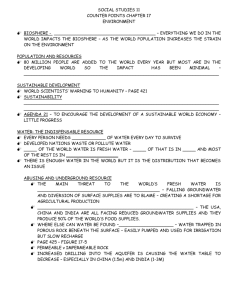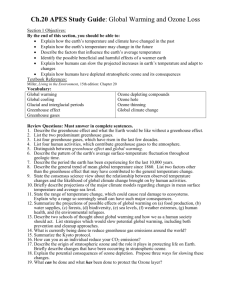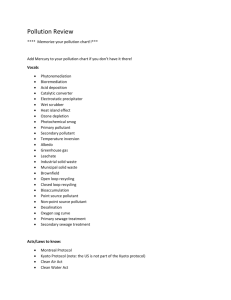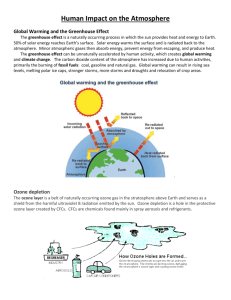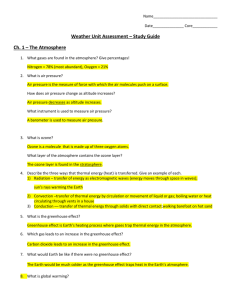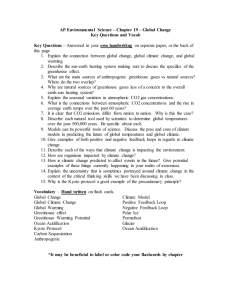UNIT 3
advertisement
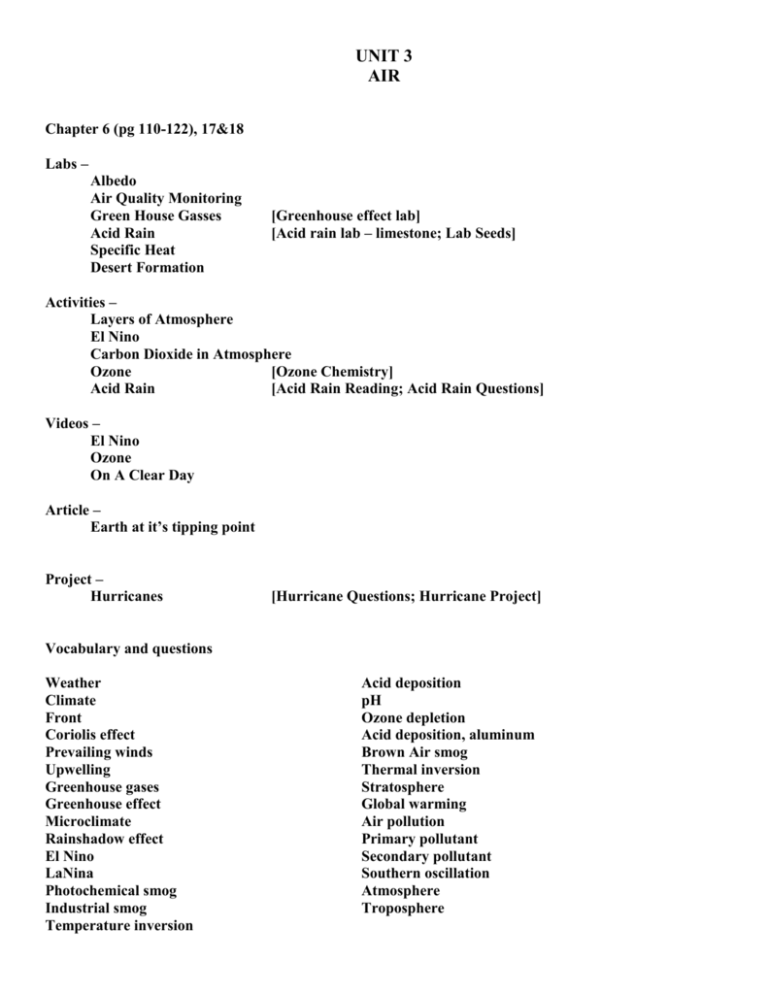
UNIT 3 AIR Chapter 6 (pg 110-122), 17&18 Labs – Albedo Air Quality Monitoring Green House Gasses Acid Rain Specific Heat Desert Formation [Greenhouse effect lab] [Acid rain lab – limestone; Lab Seeds] Activities – Layers of Atmosphere El Nino Carbon Dioxide in Atmosphere Ozone [Ozone Chemistry] Acid Rain [Acid Rain Reading; Acid Rain Questions] Videos – El Nino Ozone On A Clear Day Article – Earth at it’s tipping point Project – Hurricanes [Hurricane Questions; Hurricane Project] Vocabulary and questions Weather Climate Front Coriolis effect Prevailing winds Upwelling Greenhouse gases Greenhouse effect Microclimate Rainshadow effect El Nino LaNina Photochemical smog Industrial smog Temperature inversion Acid deposition pH Ozone depletion Acid deposition, aluminum Brown Air smog Thermal inversion Stratosphere Global warming Air pollution Primary pollutant Secondary pollutant Southern oscillation Atmosphere Troposphere Questions Unit 3/Air Chapter 6 1. Distinguish between weather and climate. Summarize how warm fronts, cold fronts, high pressure air masses, and low pressure air masses effect weather. 2. Describe at least five different factors which contribute to global air circulation patterns. Distinguish between tornado and a typical tropical cyclone. Describe how ocean currents generally redistribute heat. 3. Describe an El Nino/ Southern Oscillation and a La Nina. What distinct weather features are in each. 4. Describe an upwelling and how it might be affected by an El Nino-Southern Oscillation. 5. Define greenhouse effect. Name the greenhouse gases. State the significance of the greenhouse effect. Chapter 17 6. Briefly describe the structure of the atmosphere being sure to include troposphere, stratosphere, mesosphere, and the boundaries between each set of layers. 7. Summarize ways in which humans disrupt Earth’s major gaseous nutrient cycle. 8. Distinguish between primary pollutant and secondary pollutant; stationary sources and mobile sources; photochemical smog and industrial smog. List eight major classes of primary outdoor pollutants. Describe hoe smog is formed. Describe a thermal inversion and conditions under which it is most likely to occur. 9. Define acid deposition. Identify the level of risk that acid deposition creates for human health. Give one example of the complexities of interactions that can be set in motion by acid deposition. List six strategies to prevent acid deposition. 10. Compare the risks of indoor and outdoor air pollution. List four most dangerous indoor air pollutants, the potential health effects of each, and strategies for dealing with each. 11. Briefly describe how air pollution affects human health, plants, aquatic life, and materials. 12. Summarize the Clean Air Act. List six criticisms that environmentalists make about the Clean Air Act. Summarize the controversy over the strictor particle emission standards in the USA. 13. List four prevention strategies and three cleanup strategies to reduce emissions from stationary sources of air pollution. Define emissions trading policy and tell which are being regulated by this policy. 14. List eight prevention strategies and three cleanup strategies to reduce emission from motor vehicles. List six prevention strategies and six cleanup strategies to reduce indoor pollution. Chapter 18 1. Describe the greenhouse effect and what the Earth would be like without a greenhouse effect. List two predominant greenhouse gases. List four greenhouse gases that have risen in the last few decades. List four human activities that contribute greenhouse gases to the atmosphere. Distinguish between Greenhouse effect and global warming. 2. Describe the pattern of the earth’s average surface-temperature fluctuation throughout geologic time. Describe the period the earth has been experiencing for the last 10,000 years. 3. Describe the general trend of mean global temperature since 1860. List two factors other than then greenhouse effect that may have contributed to the general temperature change. 4. Briefly describe projections of the major climate models regarding changes in mean surface temperature and average sea level. List eight important factors that lend considerable uncertainty to climate models and their projections. 5. State the range of temperature change that could cause real damage tp ecosystems. Explain why a range so seemingly small can have such major consequences. Summarize the projections of possible effects of global warming on (a) food production, (b) water supplies, (c) forests, (d) biodiversity, (e) sea levels, (f) weather extremes,(g) human health,and (h) environmental refugees. 6. Describe three schools of thought about global warming and hoe we as a human society should act. List seven strategies that would slow potential global warming, including both prevention and cleanup approaches. 7. Describe the origin of stratospheric ozone and the role it plays in protecting life on earth. Briefly describe changes which have been occurrung in the stratospheric ozone. 8. Describe the scientific work on CFC’s and their relationship to ozone. Describe the political response to the scientific information. Summarize the consensus science view of CFC’s and stratospheric ozone. Summarize alternative views that have received much attention 9. Explain the potential consequences of ozone depletion.
